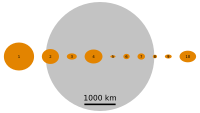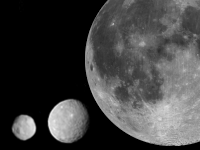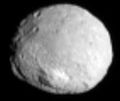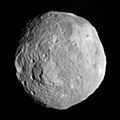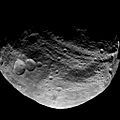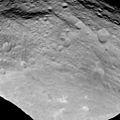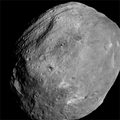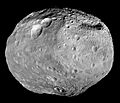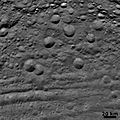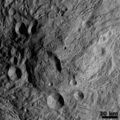4 Vesta facts for kids
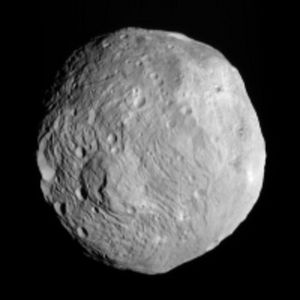
4 Vesta seen by Dawn spacecraft July 9, 2011
|
|
| Discovery | |
|---|---|
| Discovered by | Heinrich Wilhelm Olbers |
| Discovery date | March 29, 1807 |
| Designations | |
| none | |
| Main belt (Vesta family) | |
| Orbital characteristics | |
| Epoch November 26, 2005 (JD 2453700.5) | |
| Aphelion | 384.72 Gm (2.572 AU) |
| Perihelion | 321.82 Gm (2.151 AU) |
| 353.268 G m (2.361 AU) | |
| Eccentricity | 0.08902 |
| 1325.46 d (3.63 a) | |
|
Average orbital speed
|
19.34 km/s |
| 205.652° | |
| Inclination | 7.133° |
| 103.926° | |
| 150.297° | |
| Physical characteristics | |
| Dimensions | 578×560×458 km |
| Mass | 2.7×1020 kg |
|
Mean density
|
3.4 g/cm³ |
| 0.22 m/s² | |
| 0.35 km/s | |
| 0.2226 d | |
| Albedo | 0.423 (geometric) |
| Temperature | min: 85 K (-188° C) max: 255 K (-18 °C) |
|
Spectral type
|
V-type asteroid |
| 5.1 to 8.48 | |
| 3.20 | |
| 0.64" to 0.20" | |
4 Vesta is a very large asteroid found in our Solar System. It is the second most massive asteroid in the main asteroid belt. Vesta is about 530 km (330 miles) wide. It is so big and bright that it is the only asteroid you can sometimes see with your naked eye from Earth. Vesta's special symbol is ![]() .
.
Contents
Discovering Vesta
A German astronomer named Heinrich Wilhelm Olbers found Vesta on March 29, 1807. He let a famous mathematician, Carl Friedrich Gauss, choose its name. Gauss named it after Vesta, the Roman goddess of home and family.
After Vesta was found in 1807, no other asteroids were discovered for 38 years. For a while, these four known asteroids were even thought of as planets! Each had its own special symbol. Vesta's symbol often looked like a stylized hearth, which is a fireplace.
Vesta's Physical Features
Vesta is the second largest object in the asteroid belt. It has a different inside structure compared to its surface. Vesta is located in the inner part of the main asteroid belt. It is similar in volume to another asteroid called 2 Pallas, but Vesta is a bit heavier.
Vesta is almost round because of its own gravity. However, it has a very large dent and a bump near its pole. Because of these features, it doesn't quite fit the rules to be called a planet by the IAU. Even so, some scientists think Vesta might be called a dwarf planet in the future if its shape is proven to be from natural forces.
Vesta spins quite fast for an asteroid, completing a full turn in about 5.3 hours. It spins forward, meaning in the same direction as most planets. Its top (north pole) is tilted by about 29 degrees.
The temperature on Vesta's surface can change a lot. Where the Sun shines directly, it can be around -20°C. But at the winter pole, it can drop to about -190°C. On a typical day, temperatures are around -60°C during the day and -130°C at night.
Vesta's Geology
Scientists have a lot of information about Vesta's geology. This is because over 200 HED meteorites that have fallen to Earth are believed to be pieces of Vesta. These meteorites help us understand what Vesta is made of and how it formed.
Scientists believe Vesta has a metallic core made of iron and nickel. Above this core is a rocky layer called a mantle, made of a mineral called olivine. On top of that is a crust. Here's a simple timeline of how Vesta might have formed:
- Vesta finished forming about 2-3 million years after the Solar System began.
- It melted almost completely due to heat from radioactive decay. This caused the metal core to form about 4-5 million years later.
- The molten mantle slowly cooled and became solid.
- The remaining molten material came out to form the crust. This might have happened through volcanic eruptions or by forming a temporary ocean of molten rock.
- Deeper parts of the crust hardened into plutonic rocks. Older basalts (volcanic rocks) changed due to pressure from new layers.
- Finally, Vesta's inside slowly cooled down.
Vesta is the only known asteroid that has been completely reshaped by this process. However, other asteroids likely went through similar changes but were later broken apart by impacts.
Surface Features of Vesta
Scientists have used telescopes like the Hubble Space Telescope to see details on Vesta's surface.
The most striking feature is a huge crater near Vesta's south pole. It is about 460 km wide, which is about 80% of Vesta's total width! The bottom of this crater is about 13 km deep, and its rim rises 4–12 km high. The highest point in the center of the crater is 18 km tall. Scientists think the impact that made this crater blasted away about 1% of Vesta's total material. A group of smaller asteroids, called the Vesta family, are likely pieces from this huge collision. This crater is thought to be about 1 billion years old or even younger. It is also believed to be the place where the HED meteorites came from.
There are other large craters on Vesta, about 150 km wide and 7 km deep. A dark area about 200 km across is named Olbers, after Vesta's discoverer. We don't know exactly what it is, but it might be an old basaltic surface. This feature is used as a starting point for measuring longitude on Vesta.
The eastern and western sides of Vesta look quite different. The eastern side seems to be very bright and covered in many old craters. The western side has large dark areas, which are thought to be surface basalts.
Vesta's Fragments
Scientists believe that many small objects in the solar system are pieces of Vesta. These pieces broke off during collisions. Examples include Vestoid asteroids and HED meteorites. One asteroid, 1929 Kollaa, has a makeup similar to certain meteorites, suggesting it came from deep inside Vesta's crust.
Because many meteorites are thought to be from Vesta, Vesta is one of only five objects in the Solar System from which we have actual physical samples. The others are Mars, the Moon, comet Wild 2, and Earth itself.
Proof of HED Meteorite Origin
The Dawn probe orbited Vesta for 10 months. Its data helped prove that Vesta is the source of the HED meteorites. These meteorites make up about 6% of all meteorites that fall to Earth. HED meteorites contain a mineral called pyroxene, which is rich in iron and magnesium. Dawn's instruments found the exact same mineral signatures on Vesta's surface.
How to See Vesta
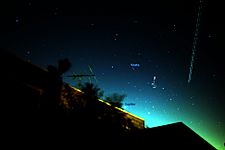
Vesta's large size and bright surface make it the brightest asteroid. You can sometimes see it with your naked eye if you are in a very dark place, away from light pollution. For example, in May and June 2007, Vesta was at its brightest since 1989.
At that time, Vesta was easy to see in the constellations Ophiuchus and Scorpius.
Even when Vesta is not at its brightest, you can often see it with binoculars.
Images for kids
-
Geologic map of Vesta. The most ancient and heavily cratered regions are brown; areas modified by the Veneneia and Rheasilvia impacts are purple (the Saturnalia Fossae Formation, in the north) and light cyan (the Divalia Fossae Formation, equatorial), respectively; the Rheasilvia impact basin interior (in the south) is dark blue, and neighboring areas of Rheasilvia ejecta (including an area within Veneneia) are light purple-blue; areas modified by more recent impacts or mass wasting are yellow/orange or green, respectively.
-
First image of asteroids (Ceres and Vesta) taken from Mars. The image was made by the Curiosity rover on 20 April 2014.
-
Artist's conception of Dawn orbiting Vesta
-
Conjunction of Ceres and Vesta near the star Gamma Virginis on 5 July 2014 in the Constellation of Virgo.
-
Albedo and spectral maps of 4 Vesta, as determined from Hubble Space Telescope images from November 1994
-
Vesta seen by the Hubble Space Telescope in May 2007
See also
 In Spanish: (4) Vesta para niños
In Spanish: (4) Vesta para niños


